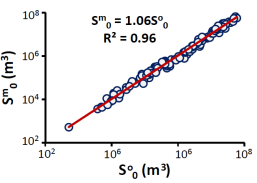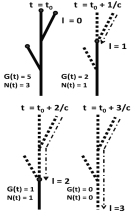|
In nature, the spectrum of preferred scales tends to have concentrations around discrete states which seem to be rather far apart. In physics we have the quanta, subatomic particles, atoms, molecules… in biology we see a similar pattern with distinct nodes at the following levels: molecule, cell, organism, species, ecosystem. Although these levels are only few in number, it took thousands of years to identify them, to recognize them as possessing distinct qualities. But once such a node on the spectrum of scale has been discovered, the rewards have been great because it provided a firm basis for conceptualization and led to a rapid development of science through workable theories and models. - Vit Klemes, 1983
A good amount of hydrologic research has become of interest to many disciplines, which up to now had very little to share with hydrology. - Ignacio Rodriguez-Iturbe and Andrea Rinaldo, 1997
|

|
Drought Hydrology and My Work Flow rate in river channels decreases continuously over time during drought or no-rain periods. This phenomenon is also known as recession flow. Drought hydrology is one of the oldest subjects in the hydrologic literature, with the most widely recognized drought flow study dating back to Boussinesq (1877). Boussinesq’s model is based on the assumption that recession flows are controlled only by Darcian drainage from phreatic aquifers. In my view, drought hydrology was taken another giant step forward by Brutsaert and Nieber (WRR, 1977), exactly a hundred years after Boussinesq (1877), who proposed expressing time derivative of discharge (dQ/dt) as a function of discharge (Q) itself, a simple yet very powerful analytical framework that can help revealing many interesting properties of recession flow curves. This is also one of the finest examples that wonderful scientific contributions can be wonderfully simple! My work deals with some of the limitations of the above two studies. Brutsaert and Nieber (WRR, 1977) found that (dQ/dt, Q) data points from the recession events of a basin follow a power law form although they create significant noise or scatter around the regression line. They attributed the noise to drainage from non-phreatic storage systems and suggested to consider the lower envelope of the (dQ/dt, Q) data cloud. Since then, many studies have been carried out to explain and eliminate the noise. The fundamental flaw here, however, is that dQ/dt-Q relationship for a basin is assumed to be unique. In fact, dQ/dt vs. Q curves from different recession events tend to fall far apart from one another, signifying that a dQ/dt vs. Q curves have their own unique identities and hence they must be analyzed individually (Biswal and Marani, GRL, 2010). Individual recession curve analysis has revealed many interesting facts about how natural basins store and drain water (Shaw and Riha, JoH, 2012; Shaw et al., WRR, 2013; Mutzner et al., WRR, 2013; Biswal and Nagesh Kumar, HP, 2014; Biswal and Marani, AWR, 2014; Biswal and Nagesh Kumar, AWR, 2014; Patnaik et al., manuscript to be submitted to AWR). Still today, most studies use Boussineq’s model to predict recession flows even though there is not a single evidence supporting its main hypothesis. On the contrary, observations from many sites suggest that phreatic aquifers do not very well explain recession flows in real river basins (Biswal and Nagesh Kumar, AWR, 2014). To my understanding, this disagreement is because rain water can take many types of flow pathways (Toth, JGR, 1962) to reach the basin outlet and Boussinesq’s model considers only one type of flow pathway (local). If groundwater flow follows only local flow paths, different points in a river network will take equal amount of time to dry. But we all know lower order channels in a river basin dry before higher order streams! I hold the view that subsurface flow processes are represented by the drying pattern of the channel network and, consequently, the branching structure of the channel network determines the shape of the recession flow curves. Geomorphological recession flow model (GRFM) captures the key recession flow curve characteristics quite well by assuming that flow generation per unit active channel network length and the speed at which active channel heads are moving downstream remain constant during a recession event (Biswal and Marani, GRL, 2010). GRFM also helps us in understanding the universal characteristics of recession flow curves (Biswal and Marani, AWR, 2014) and the effect of spatial rainfall variation on them (Biswal and Nagesh Kumar, HP, 2014). An accurate representation of recession flow processes is particularly essential in estimating (subsurface) water storage which sustains water supply to humans and freshwater ecosystems. One prevailing problem regarding this objective is that storage-discharge relationship during early recession phases is different from that of during late recession phases, and the traditional hydrological models do not explain this difference well. GRFM, however, quite accurately captures the transition of storage-discharge relationship from exponential to power law (Biswal and Nagesh Kumar, manuscript in review at AWR). With suitable manipulations a simple analytical expression can be obtained that is quite accurately predicting drainable storage. Potential implications of this include better management of fresh water resources and ecosystems and more accurate hydrological inputs for climate models. An important question here is if the good performance by GRFM automatically means that its hypotheses are true. We actually do not have enough reliable data to answer this question. It might be possible that the hypotheses are not realistic. It is interesting that many different sets of assumptions can draw GRFM like conclusions (Biswal and Nagesh Kumar, WRR, 2013). Nevertheless, the bottom-line always remains unchanged, that the branching structure of a channel network shapes the recession flow curves. A Few Words of Acknowledgement Many people have directly or indirectly helped me in achieving what I have achieved. Vit Klemes’ article (Conceptualization and scale in hydrology, JoH, 1983) inspired me to pursue PhD in hydrological science. Prof. Marco Marani (my PhD advisor) motivated me to research on drought hydrology and taught me many useful things. Prof. Andrea Rinaldo provided many useful insights and his encouragement throughout my PhD was indispensable. Prof. Nagesh Kumar contributed to my growth as a researcher by providing me opportunities for co-advising.
Current Work Currently I am developing a channel network based hydrological model for forecasting both drought and flood. I am also trying to use GRACE satellite data in conjunction with GRFM to improve prediction of subsurface storage. Another topic of interest to is the effect of climate on flow in river channels (Botter et al., PNAS, 2013) .
To go back to my homepage click here. |

|
Death Valley, CA, Dec 2010 |
|
Has it ever occurred to you that river basins around the world are strikingly similar to one another? In a brief observation our earth's surface may look infinitely complex, but a closer and thoughtful look can reveal many interesting patterns characterizing river basins situated in different climatic and geologic regions. Over the past few years I have been looking at how the structural similarities of river basins are encoded in streamflows. I believe channel networks best represent natural basins, in the way they organize themselves as well as in the way they drain water and transport solutes. |
|
dQ/dt vs. Q curves are very different from one another (Biswal and Marani, GRL, 2010) |
|
GRFM explained: a hypothetical channel network undergoing recession process by following the assumption that flow generation and speed of desaturation remain constant for the recession event (Biswal and Marani, GRL, 2010) |

|
Contrary to the hypothesis made by Boussinesq, phreatic aquifer height hardly controls recession curve characteristics (Biswal and Nagesh Kumar, AWR, 2014) |

|
The GRFM based simple analytical equation predicts initial drainable storage quite accurately (Biswal and Nagesh Kumar, in review at AWR) |

